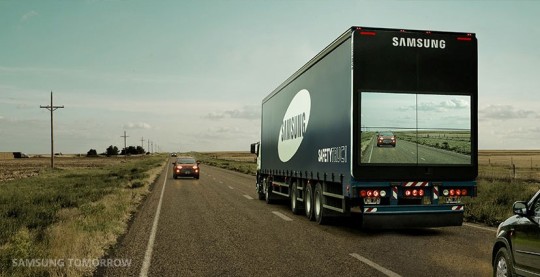
There have been all kinds of fun new ways that technology has become embedded into cars to help drivers.
Last Friday, the New York Times had an article about Audi’s testing what might be described as a driver-assisted race car, going 120 miles per hour.
Just last month, Samsung demonstrated a way to see through truck on country roads in Argentina. It was intended to help a driver know when it’s safe to pass and overtake the truck. But, even those of us who get stuck in massive urban traffic jams, would love the ability to see ahead. (See the picture above.)
Another version of the same idea was developed and unveiled last month by the Universitat Politècnica de València, Spain. They call their version EYES and you can see a report about it at https://youtu.be/eUQfalxPK0o

There have been variations on this theme over the last year or so, but so far the deployment of the technology hasn’t happened on real roads for regular drivers.
But Ford Motor Company announced a couple of weeks ago that it will start to equip a car this year with split view cameras that let drivers see around corners. They say it’s especially useful when backing into traffic. This is supposed to be a feature of their worldwide fleet of cars by 2020.

In the old days, when a driver had to maneuver into a tight corner, he/she asked a friend to stand outside the car and provide instructions. Now, Land Rover is helping the driver who is alone – without friends? – to get a better view and control the car at the same time by using a smart phone app.

Is this all a good thing? The New York Times had this quote in its Audi story:
“At this point, substantial effort in the automotive community is focused on developing fully autonomous driving technology,” said Karl Iagnemma, an automotive researcher at M.I.T. “Far less effort is focused on developing methods to allow a driver to intuitively and safely interact with the highly automated driving vehicle.”
Nevertheless, while these features are surely helpful, on balance, they seem to me to be transitional technologies. (Allen Wirfs-Brock provided this helpful slide on the subject.)

A good example was the enhancement of controls for elevator operators when the average passenger could press the very same automated buttons. Or similarly, the attempt by horse-drawn carriage makers to keep up with auto makers until they firmly lost the battle a hundred years ago. Maybe Polaroid cameras were the transitional technology between film that needed to be developed at a factory and pictures you can take on your phone.

The warning signs are there already. In May 2015, WIRED magazine featured this story, “Google’s Plan to Eliminate Human Driving in 5 Years”.
Also in May, Uber and its partner, Carnegie Mellon University, did a test drive of its first autonomous vehicle. Of course, Uber’s plans and its role in disrupting the traditional taxi industry had already led to dire predictions like this one on the website of the CBS TV station in San Francisco: “How Uber’s Autonomous Cars Will Destroy 10 Million Jobs And Reshape The Economy by 2025”.
Based on their promise last October, pretty soon we should soon start to Tesla delivering a car that “will be able to self-drive 90 percent of the time”.
Indeed, taking this idea to its ultimate extreme conclusion, the Guardian reported a few months ago that Tesla’s CEO, Elon Musk, wants to ban human driving altogether. They quote him as saying:
“You can’t have a person driving a two-tonne death machine”.
So while it will be fun, perhaps we’re just seeing the last gasp of human driving.
© 2015 Norman Jacknis
[http://njacknis.tumblr.com/post/124749211027/better-driving]
